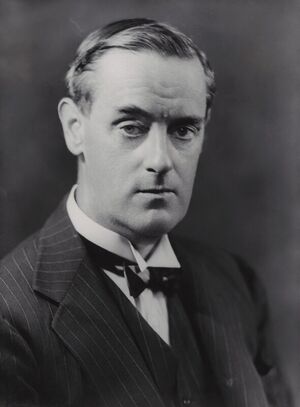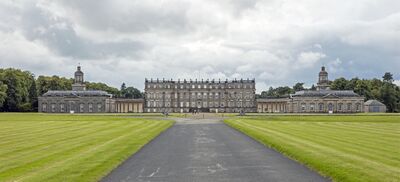Victor Hope
( British nobility) | |
|---|---|
 | |
| Born | 24 September 1887 South Queensferry, Linlithgowshire, Scotland |
| Died | 1952-01-05 (Age 64) South Queensferry, Linlithgowshire, Scotland |
| Alma mater | Eton College |
| Religion | Presbyterian |
| Spouse | Doreen Maud Milner |
| Interests | Milner Group |
Victor Alexander John Hope, 2nd Marquess of Linlithgow was a British politician and colonial administrator, and the eldest son of John Hope, 1st Marquess of Linlithgow.
From April 1933 to November 1934 he was chairman of the Parliamentary Joint Select Committee on Indian constitutional reform, drawn up to consider the proposals for Indian self-government. He was Governor-General and Viceroy of India from 1936 to 1943, the longest in the history of the Raj He was usually referred to simply as Linlithgow.
Early life and family
Hope was born at Hopetoun House, South Queensferry, Linlithgowshire, Scotland, on 24 September 1887.
He was the eldest son of John Adrian Louis Hope, 7th Earl of Hopetoun, later 1st Marquess Linlithgow, and Hersey Everleigh-de-Moleyns, Countess of Hopetoun and later Marchioness of Linlithgow, daughter of the fourth Baron Ventry.[1] His godmother was Queen Victoria.[2]
On April 19, 1911, Victor Hope married Doreen Maud Milner (1886-1965), the daughter of Sir Frederick Milner, a Conservative Party politician. The marriage resulted in two sons and three daughters.
He was educated at Eton College and on 29 February 1908 succeeded his father as 2nd Marquess of Linlithgow.
In 1912, aged only 25, he was elected a Fellow of the Royal Society of Edinburgh. His proposers were William Turner, Alexander Crum Brown, Cargill Gilston Knott and James Haig Ferguson. He was the society's vice president from 1934 to 1937.[3]
Early career
Linlithgow served as an officer on the Western Front during the First World War. Transferred from Lothians and Border Horse, he commanded a battalion of the Royal Scots. He was mentioned in dispatches and appointed an Officer of the Order of the British Empire, ending the war with the rank of colonel.
He then served in various minor roles in the Conservative governments of the 1920s and '30s. From 1922 till 1924 he served as the civil lord of the Admiralty, becoming chairman of the Unionist Party Organisation in 1924 for two years. He was also president of the Navy League from 1924 until 1931. He was chairman of the Medical Research Council and of the governing body of the Imperial College London. Linlithgow was also chairman of the committee on the distribution and prices of agricultural produce and president of the Edinburgh and East of Scotland College of Agriculture until 1933. In 1926 he was chairman of the Royal Commission on Agriculture in India, which published its findings in 1928.[4] [5] The reason for sending a Commission on Agriculture under Linlithgow was 'because constitutional reform without economic and educational reform will do nothing to ameliorate the condition of life of the mass of the population of India, and this is what matters most.'[6]
From April 1933 to November 1934 he was chairman of the Parliamentary Joint Select Committee on Indian constitutional reform, drawn up to consider the proposals for Indian self-government contained in the government's March 1933 White Paper. He agreed to take the job after Lord Salisbury declined it (although he agreed to serve on the committee) and Sidney Peel, the second choice, fell ill with phlebitis. Linlithgow told the Joint Select Committee that he would show no favouritism between the Indian factions (Hindus, Muslims and Princely States) and would be neutral just as he was between his own five children. The committee's proposals became the Government of India Act 1935.[7]
Viceroy
Having previously declined both the governorship of Madras and the governor-generalship of Australia (his father was the first Governor-General of Australia),[8] he became the Viceroy of India,[1] succeeding Lord Willingdon. Travelling out to India on the P&O liner RMS Strathmore, he arrived in Bombay, with his wife, daughters, and personal staff, on 17 April 1936.[9] Linlithgow implemented the plans for local self-government embodied in the Government of India Act 1935, which led to provincial governments led by the Congress Party in five of the eleven provinces of British India, but the recalcitrance of the princes prevented the establishment of elected governments in most of the princely states.
On the occasion of his appointment, the Spectator[10] wrote a short commendation of the new viceroy:
To be Viceroy of India in these troubled times calls for a rare combination of qualities. Of Lord Linlithgow’s grasp of the constitutional reforms which he will have to introduce, there is, of course, no question; but of his personality little is known. Mr. Baldwin’s choice has fallen on a man who has never sought the limelight. […] In appearance and manner he is a fine type of British aristocrat. Tall, robust and erect in figure, he has a way of inclining his head like Jove on Olympus. […] Clearly a dominating personality with a force of character and subtlety of intellect above the average. […] The Viceroy-Designate is still young, and has yet to prove that he possesses the highest gifts of statesmanship and administration. But his friends feel every confidence that there is no man living of his generation better qualified by character, intellect, and experience, to assume the burden of guiding India’s destiny in these critical times.
With the outbreak of the Second World War, Linlithgow's rejection of the request by the Congress for a declaration that India would be given the chance to determine its own future after the war[citation needed] led to the resignation of the Congress ministries. On 8 August 1940 Lord Linlithgow made a statement on behalf of the British government. It was known as the August Offer and offered greater rights in the governance of India to the Indian people. The proposal was rejected by most Indian politicians, including the Congress Party and the Muslim League. Disputes between the British administration and Congress ultimately led to massive Indian civil disobedience in the Quit India Movement. Linlithgow suppressed the disturbances and arrested the Congress leaders. He is partly blamed for the Bengal famine of 1943 which resulted in three million deaths.[11]
Indians were less kind in their assessments of his career. V. P. Menon in The Transfer of Power in India stated: "His 7½ year regime – longer than that of any other Viceroy – was conspicuous by its lack of positive achievement. When he left India, famine stalked portions of the countryside. There was economic distress due to the rising cost of living and the shortage of essential commodities. On the political side, Sir Tej Bahadur Sapru expressed the general feeling thus: 'Today, I say, after seven years of Lord Linlithgow's administration the country is much more divided than it was when he came here'."
Retirement
A sincere Presbyterian, he served as Lord High Commissioner to the Church of Scotland in 1944 and 1945. He died in 1952.
References
- ↑ Jump up to: a b Viceroy at Bay: Lord Linlithgow in India, 1936–43, by John Glendevon
- ↑ Dictionary of Australian Artists Online
- ↑ https://www.royalsoced.org.uk/cms/files/fellows/biographical_index/fells_indexp1.pdf
- ↑ https://archive.org/stream/evidenceofoffice031789mbp#page/n5/mode/2up
- ↑ https://books.google.com/books?id=7bAxnPwOMd8C&q=science+technology+india
- ↑ Church, A. G. (May 1928). "The Development of Indian Agriculture". Nature. 121 (3053): 698–700.
- ↑ Butler, Rab (1971). The Art of the Possible. London: Hamish Hamilton. pp. 46–55.
- ↑ http://adb.anu.edu.au/biography/hopetoun-seventh-earl-of-6730
- ↑ News and Views (1936), p. 5: "Lord and Lady Linlithgow, together with their three daughters and personal staff, arrived by the new P & O liner S. S. Strathmore on Friday, April 17, in the early morning, and were escorted into Bombay harbor by the ships of the Royal Indian Navy".
- ↑ http://archive.spectator.co.uk/article/16th-august-1935/7/occasional-biographies-viii-lord-linlithgow
- ↑ Richard Stevenson, Bengal Tiger and British Lion: An Account of the Bengal Famine of 1943
